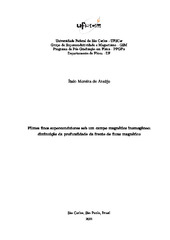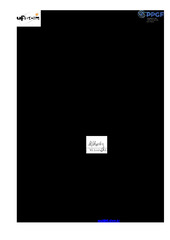| dc.contributor.author | Araújo, Ítalo Moreira de | |
| dc.date.accessioned | 2021-04-10T12:41:35Z | |
| dc.date.available | 2021-04-10T12:41:35Z | |
| dc.date.issued | 2021-03-25 | |
| dc.identifier.citation | ARAÚJO, Ítalo Moreira de. Filmes finos supercondutores sob um campo magnético inomogêneo: diminuição da profundidade da frente de fluxo magnético. 2021. Dissertação (Mestrado em Física) – Universidade Federal de São Carlos, São Carlos, 2021. Disponível em: https://repositorio.ufscar.br/handle/ufscar/14100. | * |
| dc.identifier.uri | https://repositorio.ufscar.br/handle/ufscar/14100 | |
| dc.description.abstract | The phenomenon of superconductivity was discovered by scientist Heike Kamerlingh Onnes in 1911, while studying the resistivity of mercury when cooled below 4,2 K. As predicted by Alexei Abrikosov in 1957, materials from a class of superconductors - currently labeled as Type II - when in the presence of a magnetic field, do admit the entry of flux, in the form of vortices, even being in the superconducting state. A relevant problem for the application of superconductors is the movement of these vortices in the material, which generates dissipation and leads to a local increase in temperature, making the superconducting state less robust. One of the strategies used to avoid this unwanted effect, which results from the viscous movement of vortices, is the artificial inclusion of pinning centers, which act as potential wells for the vortices, making it difficult for them to move.
Recently, a considerable number of studies have been directed to the so-called conformal arrangements, which are characterized by the maintenance of the hexagonal symmetry of the original vortex lattice and the introduction of a gradient in the spatial distribution of pinning centers, in the form of arcs, promoting a local increase in the critical current, especially in regimes of high fields and temperatures. In a recent study, performed using computer simulations carried out based on the Ginzburg-Landau theory, it was shown that through combinations of homogeneous and inhomogeneous magnetic fields, it is possible to produce a conformal arrangement of vortices even in a specimen without artificial inclusions. It was precisely this study that inspired the work described here.
Thus, with the use of the magneto-optic imaging technique based on the Faraday Effect, the distribution of magnetic flux and the penetration depth of the flux front in the superconducting phase of the studied device was mapped. It consists of a square film of Nb, surrounded by a loop, also square, of Nb. The device was lithographed from a 200 nm thick Nb film. In all cases treated here, the applied field was always perpendicular to the plane of the device. The field profile generated by the superconducting loop was obtained by direct calculation, using the Biot-Savart Law. The superconducting ring was properly characterized, both with respect to the applied current and the applied field at a fixed temperature, in order to guarantee conditions for the device - i.e., the ring and the film inside it - to remain in the superconducting state along the experiments.
We thus performed a series of comparisons of the penetration depth of the magnetic flux front using magneto-optic images, always maintaining an equal effective field condition. We used two sample cooling routines: one with field (FC, field cooling), which could be either homogeneous or inhomogeneous, and another in the absence of field (ZFC, zero field cooling). In addition, we also varied the sense of the FC field, always keeping in the same (positive) direction the homogeneous field that was applied during the experiments. The results showed a hierarchy in the penetration depth: the most profound was the negative inhomogeneous field condition, that is, the one in which antivortices were trapped in the superconductor during cooling. A significantly deeper penetration was presented for the condition of FC in a negative homogeneous field; in the sequence, the ZFC condition appears and then there is the positive homogeneous FC condition. The configuration with the lowest flux penetration depth was the one with inhomogeneous field in the same direction as the applied field.
Therefore, the interactions between the vortices nucleated by the increase in the applied field and the vortices or antivortices trapped during the cooling of the film proved to be important in favor of vortex-vortex repulsion. In addition, among the five different cooling situations which we have studied, the inhomogeneous field condition is one in which the system exhibits the greater effective shielding capacity. | eng |
| dc.description.sponsorship | Coordenação de Aperfeiçoamento de Pessoal de Nível Superior (CAPES) | por |
| dc.language.iso | por | por |
| dc.publisher | Universidade Federal de São Carlos | por |
| dc.rights | Attribution-NonCommercial-NoDerivs 3.0 Brazil | * |
| dc.rights.uri | http://creativecommons.org/licenses/by-nc-nd/3.0/br/ | * |
| dc.subject | Supercondutividade | por |
| dc.subject | Filmes finos | por |
| dc.subject | Corrente crítica | por |
| dc.subject | Arranjos conformes | por |
| dc.subject | Imageamento via magneto-ótica | por |
| dc.subject | Superconductivity | eng |
| dc.subject | Thin films | eng |
| dc.subject | Critical current | eng |
| dc.subject | Conformal arrays | eng |
| dc.subject | Magneto-optical imaging | eng |
| dc.title | Filmes finos supercondutores sob um campo magnético inomogêneo: diminuição da profundidade da frente de fluxo magnético | por |
| dc.title.alternative | Superconducting thin films under an inhomogeneous magnetic field: diminution of the magnetic flux front depth | eng |
| dc.type | Dissertação | por |
| dc.contributor.advisor1 | Ortiz, Wilson Aires | |
| dc.contributor.advisor1Lattes | http://lattes.cnpq.br/0241177338066307 | por |
| dc.contributor.advisor-co1 | Motta, Maycon | |
| dc.contributor.advisor-co1Lattes | http://lattes.cnpq.br/8340540626164812 | por |
| dc.description.resumo | O fenômeno da supercondutividade foi descoberto pelo cientista Heike Kamerlingh Onnes em 1911, enquanto estudava a resistividade do mercúrio quando resfriado abaixo de 4,2 K. Como previsto por Alexei Abrikosov em 1957, materiais de uma classe de supercondutores - rotulada atualmente como sendo do Tipo II - quando na presença de um campo magnético, admitem a entrada de fluxo, na forma de vórtices, mesmo estando ainda no estado supercondutor. Um problema relevante para aplicação dos supercondutores é a movimentação desses vórtices no material, que gera dissipação, levando a um aumento local de temperatura, tornando o estado supercondutor menos robusto. Uma das estratégias utilizadas para evitar esse efeito indesejado, que decorre da movimentação viscosa dos vórtices, é a inclusão artificial de centros ancoradores, os quais atuam como poços de potencial para os vórtices, dificultando sua movimentação.
Recentemente, um número apreciável de estudos vêm sendo dirigidos aos chamados arranjos conformes, que se caracterizam pela manutenção da simetria hexagonal da rede original e a introdução de um gradiente na distribuição espacial de centros de ancoramento na forma de arcos, promovendo aumentos locais na corrente crítica, especialmente em regimes de altos campos e temperaturas. Em recente estudo, conduzido a partir de simulações computacionais realizadas com base na teoria de Ginzburg-Landau, foi mostrado que mediante combinações de campos magnéticos homogêneos e inomogêneos, é possível produzir um arranjo conforme dos vórtices mesmo em um espécime sem inclusões artificiais. Foi justamente esse estudo que inspirou a realização do trabalho aqui exposto.
Assim, com a utilização da técnica de imageamento via magneto-ótica baseada no Efeito Faraday, mapeou-se a distribuição de fluxo magnético e a profundidade de penetração da frente de fluxo na fase supercondutora do dispositivo estudado. Trata-se de um filme quadrado de Nb, circundado por uma espira, também quadrada, de Nb. O dispositivo foi litografado a partir de um filme de Nb com 200 nm de espessura. Em todos os casos aqui tratados, o campo sempre foi aplicado perpendicularmente ao plano do dispositivo. O perfil de campo gerado pela espira supercondutora foi obtido para um loop de corrente por cálculo direto, usando a lei de Biot-Savart. O anel supercondutor foi devidamente caracterizado, tanto com relação à corrente aplicada quanto ao campo aplicado em uma temperatura fixa, a fim de garantir condições para que o dispositivo - i.e., o anel e o filme em seu interior - permanecessem no estado supercondutor durante os experimentos.
Realizamos então uma série de comparações da profundidade de penetração da frente de fluxo magnético usando imagens de magneto-ótica, mantendo sempre uma condição de campo efetivo igual. Usamos duas rotinas de resfriamento da amostra: uma com campo (FC, field cooling), que podia ser homogêneo ou inomogêneo, e outra na ausência de campo (ZFC, zero field cooling). Além disso, variamos também o sentido do campo FC, mantendo sempre no mesmo sentido (positivo) o campo homogêneo que era aplicado durante os experimentos. Os resultados mostraram uma hierarquia na profundidade de penetração: a mais profunda foi a condição de campo inomogêneo negativo, isto é, aquela em que antivórtices foram aprisionados no supercondutor durante o resfriamento. Uma profundidade sensivelmente menor foi apresentada para a condição de FC em campo homogêneo negativo; na sequência, aparece a condição de ZFC e, em seguida, está a condição de FC em campo homogêneo positivo. A configuração com menor profundidade de penetração foi aquela com campo inomogêneo no mesmo sentido do campo aplicado. Portanto, as interações entre os vórtices nucleados pelo aumento do campo aplicado e os vórtices ou antivórtices aprisionados durante o resfriamento do filme mostraram-se importantes em favor da repulsão vórtice-vórtice. Além disso, dentre as cinco situações de resfriamento estudadas, a condição de campo inomogêneo é aquela em que o sistema exibe uma maior capacidade efetiva de blindagem. | por |
| dc.publisher.initials | UFSCar | por |
| dc.publisher.program | Programa de Pós-Graduação em Física - PPGF | por |
| dc.subject.cnpq | CIENCIAS EXATAS E DA TERRA::FISICA::FISICA DA MATERIA CONDENSADA::SUPERCONDUTIVIDADE | por |
| dc.description.sponsorshipId | CAPES: 08898340001-08 | por |
| dc.publisher.address | Câmpus São Carlos | por |
| dc.contributor.authorlattes | http://lattes.cnpq.br/1566463426300587 | por |


